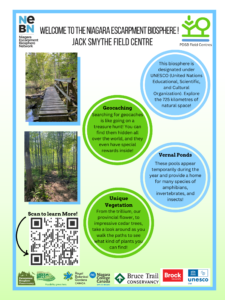STEWARDSHIP, RESTORATION, AND MONITORING
Stewardship in a Spirit of Collaboration
Through collaboration with key right holders and key stakeholder groups, conservation and restoration projects are being identified, developed, and delivered within the Niagara Escarpment Biosphere. Stewardship activities are being integrated into activities in the various regions of the Niagara Escarpment Biosphere to ensure the monitoring of biodiversity, ecosystem services, and restoration and conservation projects.

What are biosphere reserves?
Background
Biosphere reserves are sites recognized by UNESCO’s Man and the Biosphere Programme and are models of a sustainable future that protect and celebrate cultural and biological diversity, and that empower people to engage with one another and with nature in healthier ways. Biosphere reserves in Canada are designated areas where communities are actively working to conserve biodiversity and implement the UN Sustainable Development Goals supported by Canada.
Zones
Biosphere reserves have three distinct zones:
- a core protected area, consisting of a strictly protected ecosystem (e.g. national wildlife area, migratory bird sanctuary, or national park) that contributes to the conservation of landscapes, ecosystems, species, and genetic variation.
- a buffer zone, used for limited activities, compatible with sound ecological practices that can reinforce scientific research, monitoring, training, and education; and
- a transition area, where greater activity is allowed, fostering socio-culturally and ecologically sustainable economic and human development.
For more information, check out the official UNESCO website at unesco.org/en/mab/wnbr/about
What is UNESCO?
UNESCO stands for the United Nations Educational, Scientific, and Cultural Organization. UNESCO aims to uplift and support the sharing of knowledge, culture, and peace. The organization is involved in numerous projects internationally and is responsible for forming and tackling the Sustainable Development Goals.
What is the MAB program?
The Man and the Biosphere (MAB) programme is meant to forge stronger bonds between us and the environments we live within and around. It is one of the programmes of UNESCO and has the responsibility to designate and renew the designation of all biosphere reserves in the world. It promotes biodiversity conservation and sustainable development. The MAB believes that humans need to work together with nature to continue to thrive. With both financial and cultural investment in our biosphere’s wellbeing, we can encourage everyone to work together with nature. In turn, these ecosystems will provide benefits to human livelihood and ensure our welfare.
For more information, check out the official UNESCO website at unesco.org/en/mab/about
What is a designation and how does it happen?
When biosphere reserves are adopted under the UNESCO umbrella, they become designated sites and are internationally recognized. To become designated, in Canada, a group who will be responsible for the management of the biosphere must prepare the documentation provided by the MAB programme and submit first to the Canadian Commission for UNESCO for evaluation. Once endorsed, it is then submitted to the MAB programme, which will evaluate the merit and its International Coordinating Council (ICC) will recommend its approval for the General Conference. The management of these spaces remains on the local level and is not the responsibility of MAB to maintain, making it even more crucial that communities get involved in supporting their biospheres! The designation is not a legal commitment or obligation, and local governments continue governing their territories.
To ensure the effective implementation of the MAB Strategy 2015-2025, the Lima Action Plan for UNESCO’s Man and the Biosphere (MAB) Programme and its World Network of Biosphere Reserves was adopted by the 28th MAB ICC in March 2016. Within the Lima Action Plan is a set a list of targeted outcomes, actions, and outputs aimed to achieve the Sustainable Development Goals and implementation of the 2030 Agenda for Sustainable Development, both within biosphere reserves and beyond. Actions A2.2. and A2.3. stipulate that the nomination and management of biosphere reserves must take into account local and Indigenous practices, traditions and cultures. For more information, check out the Lima Action Plan.
For more information, check out the official UNESCO website at unesco.org/en/mab/wnbr/about
What is biodiversity? Why is it important?
Biodiversity is all the different kinds of life you’ll find in one area—the variety of animals, plants, fungi, and even microorganisms like bacteria that make up our natural world. Each of these species and organisms work together in ecosystems, like an intricate web, to maintain and support life. Biodiversity supports everything in nature that we need to survive. It provides goods and services including food, clean water, medicine, and shelter. To keep nature in balance and provide a healthy, growing planet for the future, we need to make sure we are caring for and protecting the biodiversity of our homes and the world at large.
Unfortunately, human activity has led to a sharp decline in both natural resources and a variety of species populations. Land that once harboured rich ecosystems is now stripped and used for farming, and waste is constantly flowing into the rivers and oceans. To add onto that pressure, climate change has triggered more frequent storms and natural disasters, further destroying the limited environments we have left. We live in a time where life is disappearing, and if nothing changes, we may be at risk of losing even more.
The Kunming-Montreal Global Biodiversity Framework (GBF), adopted to the Convention on Biological Diversity during the 15th Conference of the Parties, outlines global goals and targets that support the achievement of the Sustainable Development Goals. Article 8(j) – Traditional Knowledge and the Convention on Biological Diversity of the GBF acknowledges the value and importance of Indigenous knowledge and consultation to sustainable development and achieving targets. On November 1st, 2024 at COP16 in Cali, Colombia, a permanent Subsidiary Body on Article 8(j) was created, providing a space for Indigenous Peoples to apply their traditional knowledge while working with the Parties and other organizations. The creation of this Subsidiary Body on Article 8(j) addresses the challenge of policy implementation on the ground by providing Indigenous Peoples with protection and support as they continue to care for and protect biodiversity on their lands. To learn more about Article 8(j), check out the Traditional Knowledge and the Convention on Biological Diversity. To learn more about the creation of the Subsidiary Body, click here.
For more information on the importance of biodiversity and how the situation looks now, check out the 2019 Global Assessment Report
What is the Niagara Escarpment?
The Niagara Escarpment runs around 1,050 kilometres from Wisconsin to beneath Lake Ontario, and 725 kilometres of it are in Canada, crossing through both boreal and temperate forests. Its rock formations were shaped over the course of hundreds of millions of years, beginning its formation 450 million years ago. The Escarpment is host to thousands of species of plants and animals and is one of the most ecologically diverse environments in all North America. It is known as Gchi-Bimadinaa in Anishinaabemowin and as Kastenhraktátye in Kanyen’kehá:ka.
Escarpments, such as the Niagara Escarpment, are dynamic places. They are unique features that attract people for their beauty and possible activities such as hiking and rock climbing. But few of us realize that escarpments like any other ecosystems evolve and change over time. Depending on their geological structure, such as the type of rocks, sections of the escarpment can “decompose” (phenomenon as rock weathering) and become rock dust or gravel.
As a natural phenomenon, this is happening to the Niagara Escarpment, including the Niagara Falls. It may take hundreds or thousands of years before it is noticeable, but it happens. The following article “The Niagara Escarpment is Crumbling—Here’s How, and Why You Should Care” explains the phenomenon. It also explains how climate change with the freeze and thaw cycles as well as storms can contribute to the erosion found along the escarpment. Human activity also factor in this. Rock climbing, for example, can increase erosion but can also impact the fragile vegetation that grows on these rocks. Dr Doug Larson from the University of Guelph studied the dynamics of this vegetation, mainly the trees, and made amazing discoveries, such as cedar trees being over 1,000 years old. You can read about these discoveries in this article “What does an old-growth forest look like in Ontario?”
The Niagara Escarpment is therefore host not only of an amazing geology but also incredible vegetation with trees hanging of these cliffs for centuries. Various plants will grow on different types of rocks. Their protection is crucial if we want the future generations to enjoy this beautiful scenery. It not only for aesthetic and enjoyment but also for carbon sequestration, an ecosystem service important to combat climate change.
To know more about the rocks and geology and how to explore it on the Niagara Escarpment, follow this link of GeoTrail: geotrail.ca.
Which ecosystems do we have in the Niagara Escarpment Biosphere?
The Niagara Escarpment Biosphere contains multiple diverse types of ecosystems, from grand boreal forests to lush Carolinian, wetlands and alvars alike. There are unique ecosystems for every type of creature and plant that calls this wide expanse home. Here are some details about the main types of ecosystems!
Carolinian Forests: These broad-leaf forests are the only of their kind in Canada, uniquely situated close to the border and several Great Lakes. The range is named after the Carolinas for their moderate temperature, allowing the growth of species like the Pawpaw, Tulip Tree, and Flowering Dogwood.
Boreal Forests: The northern forests consist of great Pines and Cedars, including some particularly Ancient Cedars that grow within the rocky cliffs of the Escarpment itself. Some of these trees are thousands of years old, some of the oldest on the planet! Boreal forests also consist of a variety of wildlife, such as bears, wolves, and others.
Alvars: These prairie-like areas thrive most during the drier months and flood in the rainy seasons, due to their limited soil and limestone/dolostone composition. In places like Bruce Peninsula National Park, uncommon species like wild-chives and alpine bluegrass grow, and other alvars contain plants that are even rarer!
Fens: Unlike swamps, fens are unique in their peaty composition, the moss being a large component of the overall ecosystem makeup. They have very mineral-rich baselines with a high water table, and provide a home to species like muskrats, kingfishers, and a wide array of amphibious creatures!
Lakes, Rivers, and Ponds: It wouldn’t be Ontario without some large bodies of water! These are home to a variety of aquatic creatures and plants, alongside being important sources of water for other landlocked animals.
What can I do to help?
Here are some ways you can help support your local biosphere!
- Experience it for yourself! Tread respectfully along the many trails and paths made to help curious folk learn and explore the beauty of Niagara for themselves. The best way to understand and want to help something is to get up close and personal with it, and we’re sure that after experiencing the wonders of the Escarpment, you’ll want to keep coming back.
- Take part in local conservation efforts. You can make a difference by volunteering to pick up garbage, plant trees, and care for the wildlife! No action is too small to make an impact, and it can be a positive experience for you too!
- Be mindful of waste! When exploring the biosphere, make sure you treat the land and creatures with the love and respect they deserve, not leaving garbage, disrupting ecosystems, or doing any harm.
- Support local organizations and become partners of Niagara Escarpment Biosphere Network (NEBN) to care for the space. The NEBN was established to support the management of the Niagara Escarpment Biosphere as a community-led, grassroots organization that is committed to a co-governance structure that works in Two-Eyed Seeing and Ethical Space. The NEBN works to meet the criteria and standards required by the United Nations Educational, Scientific, and Cultural Organization (UNESCO).
- There are many organizations involved in biosphere stewardship in all of Ontario! Many hardworking folks work day in and day out to research, explore, and maintain the sanctity and safety of the biosphere, and they all have a variety of ways to share your support!
The Escarpment Biosphere Conservancy is a non-profit organization with headquarters in Toronto, Ontario, and is the largest Ontario-focused land conservancy agency.
The Bruce Trail Conservancy is a non-profit organization in Hamilton, Ontario, with the focus of conserving and caring for the land within the Niagara Escarpment Biosphere.
The Niagara Escarpment Commission is an agency of the Government of Ontario working to maintain, conserve, and enhance the Niagara Escarpment through policy and regulations.
The Greenbelt Foundation maintains and supports the Greenbelt, a significant amount of land in Southern Ontario around the Golden Horseshoe, as an independent charity foundation primarily supported by the Government of Ontario.
The Royal Botanical Gardens are situated in Burlington, Ontario, with the largest garden and nature sanctuary in Canada and includes a variety of the escarpment ecosystems.

Niagara College of Applied Arts and Technology is a public college in the Niagara Region, with headquarters in Niagara-on-the-Lake, Ontario.
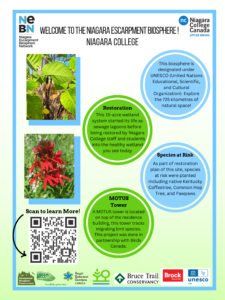
Brock University is a research-focused post-secondary institution sitting within the Niagara Escarpment Biosphere in St. Catharines, Ontario, the only university in Canada in a UNESCO biosphere reserve.
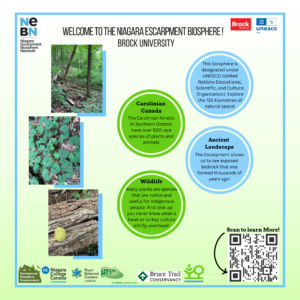
The Bruce Trail Conservancy is a non-profit organization in Hamilton, Ontario, with the focus of conserving and caring for the land within the Niagara Escarpment Biosphere.
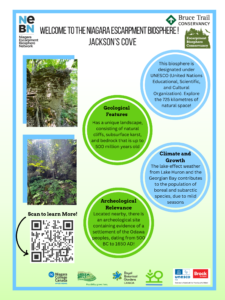
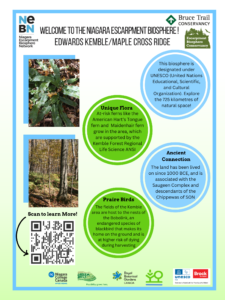
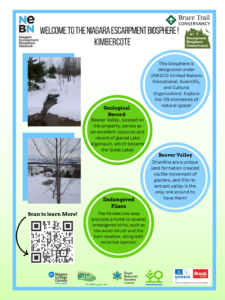
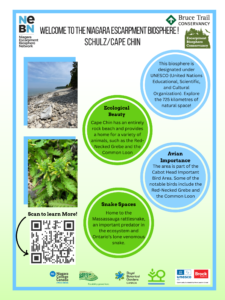
The Jack Smythe Field Centre sits atop the Niagara Escarpment and has wonderful areas to see and explore. The property itself is 186 acres with access to the Bruce Trail that winds along the perimeter.
